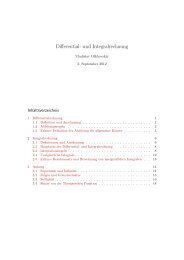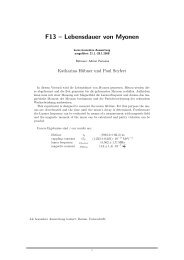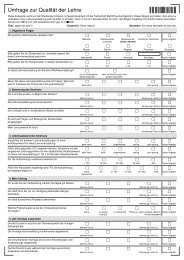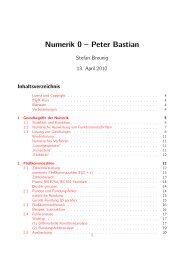Extrasolar Moons as Gravitational Microlenses Christine Liebig
Extrasolar Moons as Gravitational Microlenses Christine Liebig
Extrasolar Moons as Gravitational Microlenses Christine Liebig
Create successful ePaper yourself
Turn your PDF publications into a flip-book with our unique Google optimized e-Paper software.
CHAPTER 4. CHOICE OF SCENARIOS 41<br />
−∆mag<br />
3<br />
2<br />
1<br />
Triple Lens Binary Lens<br />
0<br />
0 0.1 0.2 0.3 0.4 0.5 0.6 0.7<br />
t/tE<br />
(a) Rsource = 2R⊙. While not <strong>as</strong> pronounced<br />
<strong>as</strong> with a solar sized source, the tell-tale signs<br />
of a caustic crossing are still visible.<br />
−∆mag<br />
3<br />
2<br />
1<br />
Triple Lens Binary Lens<br />
0<br />
0 0.1 0.2 0.3 0.4 0.5 0.6 0.7<br />
t/tE<br />
(c) Rsource = 10R⊙. The caustic crossing features<br />
are no longer distinguishable.<br />
−∆mag<br />
3<br />
2<br />
1<br />
Triple Lens Binary Lens<br />
0<br />
0 0.1 0.2 0.3 0.4 0.5 0.6 0.7<br />
t/tE<br />
(b) Rsource = 5R⊙. The planetary double<br />
peak is still noticeable, but the caustic crossing<br />
features are starting to w<strong>as</strong>h out.<br />
−∆mag<br />
3<br />
2<br />
1<br />
Triple Lens Binary Lens<br />
0<br />
0 0.1 0.2 0.3 0.4 0.5 0.6 0.7<br />
t/tE<br />
(d) Rsource = 20R⊙. The planet still reveals<br />
itself <strong>as</strong> a bump on the slope of the Paczyński<br />
curve.<br />
Figure 4.11: Testing the effect of an incre<strong>as</strong>ed source radius Rsource. Compare also<br />
figure 4.9.<br />
4.2.5 Sampling rate<br />
When observing a gravitational lensing event, data points are acquired by taking<br />
frames of the object. Typical exposure time h<strong>as</strong> a duration of 30 to 300 seconds.<br />
Higher observing frequency equals better coverage of the resulting light curve. A<br />
constant observing rate facilitates understanding of the planetary population. In real<br />
observations sampling is constrained by numerous factors. Usually, one or two dozen<br />
events must be covered at a re<strong>as</strong>onable rate during follow-up observations, because<br />
it is never certain which event will evolve to show those interesting anomalies that<br />
we look for. Ground-b<strong>as</strong>ed observations will always be weather-dependent. Then<br />
there is the Pacific gap; more of a problem, when the nights are getting shorter in<br />
the southern hemisphere.<br />
A normal microlensing event is seen <strong>as</strong> a transient brightening that l<strong>as</strong>ts for<br />
about a month. A planet will alter the light curve for hours or days; a small planet<br />
or a moon only for minutes or hours. This duration is inversely proportional to the










